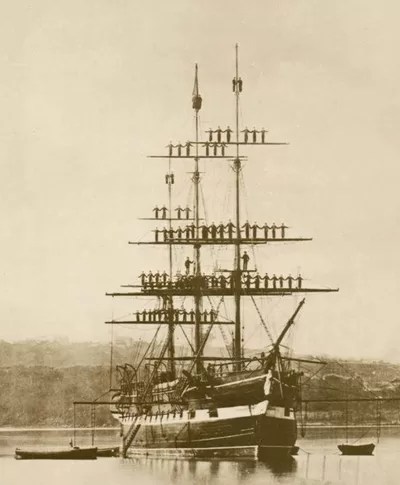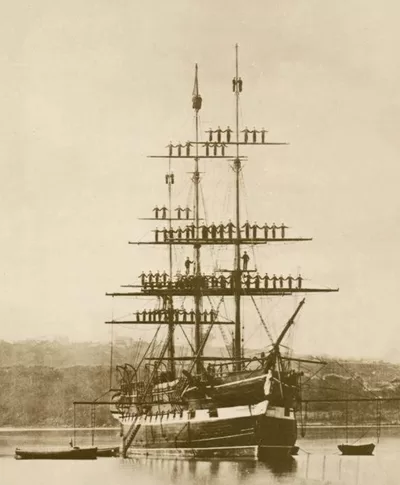The Vernon anchors are on public display outside the Australian National Maritime Museum, Darling Harbour, Sydney. The Nautical Training Ship Vernon was completed in 1839.
In 1867, the NSW Colonial Government moored the Vernon off Cockatoo Island in Sydney harbour as a floating school and as a reformatory for ‘wayward and orphaned boys’.
From 1871 to 1891 Vernon provided its schoolboy crew with access to vegetable gardens, drill grounds and recreational areas.




Left: Vernon anchor outside Australian National Maritime Museum, Sydney
Right: NTS Vernon with boys displaying their skills aloft around 1870. ANMM Collection
Research indicated that the anchors were too large to have been made for the Vernon, but at some point the ship acquired them. Curators at the Australian National Maritime Museum are now confident that the anchors were originally from a large British warship or less likely, brought out to Sydney as ballast for re-use as mooring anchors.
When curator of Historic Vessels David Payne began a technical drawing of the outlines of the anchors it was found their shape pre-dated the 1813 ‘Pering Improved’ pattern.
It appears that they were manufactured somewhere between the 1760s – when the first Admiralty anchors of this large size were ordered for HMS Victory (which was to later become famous as Admiral Nelson’s flagship at the Battle of Trafalgar) – up to 1813, when the shape of Admiralty anchors changed.
Following their use on the Vernon, the anchors continued to be used for mooring other vessels. The timber stocks dating from 1905 were once sheathed in copper to protect them. On each anchor, one of the iron flukes was bent back to avoid damage to a vessel’s hull.
Each anchor bears the broad arrow symbol of the Royal Navy and one still shows the 1839 date of manufacture.
During the 1980s members of the Seamen’s Union suggested the anchors be preserved as a memorial to sailors and with funding from BHP the museum undertook the project to preserve the anchors and place them on display.
Restoration and Conservation
Conservation is the preservation of artefacts to prevent further deterioration.
Restoration is changing an artefact to return it as close to its original appearance as possible.
The anchors from the vessel Vernon outside the Australian National Maritime Museum near Pyrmont Bridge, Darling Harbour, represent an example of conservation by application of a protective coating (both physical and chemical) for the iron and anti-rot preservatives for the timber.
The cast iron of the anchors is from 1839 and the timber stocks date to 1905. They have not been returned to an ‘as new condition’.
Electrolytic stabilisation of the anchors was not considered an option for two main reasons.
Primarily, such treatment would destroy the timber stocks or require their removal which would cause unnecessary damage.
Secondly, it was considered that the anchors were in sufficiently good condition not to require electrolytic treatment to preserve the cast iron.
The preservation process was to remove the outer corrosion and the remains of protective paint by blasting and then coating the surface with a protective material.
In 1992 after earlier temporary treatments, the iron surface of the anchors was blasted with copper slag then garnet polished (a more refined process than sand blasting).
This revealed previously unnoticed inscriptions on the anchors. The timber stocks were masked for protection during this treatment. The iron was then treated with a zinc epoxy paint.
The timber stocks were saturated with a zinc napthenate solution (copper napthenate is more effective at retarding the growth of organisms such as mould but causes green discolouration).
Display of the anchors
The brief for this project was that the anchors would be displayed outside and in an accessible environment to visitors.
This creates a challenge for the ongoing preservation of the anchors because the anchors are open to the elements of wind, rain, sun, hail, humidity, sea spray as well as attack by vandals.
A display and mounting system was built for the anchors which includes an aluminium mesh on which the anchors rest. Mesh rather than solid metal allows water to drain away and aluminium was chosen because of its electrode potential relative to the iron in the anchors.
Monitoring the conservation process
As the treatment used is less permanent than electrolytic techniques, the Vernon anchors are regularly inspected for deterioration. Being on public display as a memorial has also exposed the anchors to vandalism (2 rings were repaired and refitted after vandalism in 1992).
The anchors are also hosed with freshwater on a regular basis to reduce salt build up which occurs close to the sea.
Class Questions
What factors were considered before undertaking conservation work on the cast iron of the Vernon anchors?
Why was electrolytic conservation not chosen as a technique?
Epoxy paints form hard resinous surfaces. How will this protect the metal from corrosion?
What additional protective benefit does zinc provide in the epoxy paint? (Consider redox potential)
What deterioration do the organic timber stocks face and what was done to prevent this?
What compromise was considered in the choice of treatment of the timber stocks?
Why is an aluminium support used for the anchors on display?
Why use mesh rather than solid aluminium? (Consider environmental factors that promote corrosion)
Why are the anchors regularly hosed down, even though water is a factor in corrosion?
What other challenges do the anchors face on public display?
The Vernon anchors and HMB Endeavour cannon: conservation of two important Australian maritime artifacts on display at the Australian National Maritime Museum. An information sheet for curriculum unit Shipwrecks, Corrosion and Conservation
Compiled by Richard Neville for the Australian National Maritime Museum. Sydney. ANMM, 2003.
Chemistry teacher Richard Neville has prepared this document as a background paper for students attending the Museum’s Conservation Workshops. An excellent summary of two examples of the conservation treatments for shipwreck artifacts.
References
ANMM archives Files C07.0688 & C07.0688\2, Conservation Vernon Anchors 9088-9089 (extracts from these archives are available in the ANNM library)
More Sailing Feature stories here




